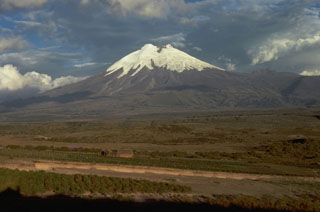Report on Cotopaxi (Ecuador) — 30 September-6 October 2015
Smithsonian Institution / US Geological Survey
Weekly Volcanic Activity Report, 30 September-6 October 2015
Managing Editor: Sally Sennert.
Please cite this report as:
Global Volcanism Program, 2015. Report on Cotopaxi (Ecuador) (Sennert, S, ed.). Weekly Volcanic Activity Report, 30 September-6 October 2015. Smithsonian Institution and US Geological Survey.
Cotopaxi
Ecuador
0.677°S, 78.436°W; summit elev. 5911 m
All times are local (unless otherwise noted)
During an overflight of Cotopaxi on 29 September, IG scientists observed low-energy pulsating emissions with low or no ash content that rose 1 km above the crater and drifted W. Fracturing continued on both the upper and lower parts of the glacier, at the toes. Rapid melting had occurred from the glacier on the upper E flank which resulted in material falling onto the lower part of the glacier. New thermal anomalies on the upper parts of the outer crater were identified, likely from newly deposited material. During 30 September-6 October gas-and-water vapor plumes sometimes with low ash content rose as high as 2 km and drifted in multiple directions. Ashfall was reported in Tanicuchí (25 km SW) on 1 October.
Geological Summary. The symmetrical, glacier-covered, Cotopaxi stratovolcano is Ecuador's most well-known volcano and one of its most active. The steep-sided cone is capped by nested summit craters, the largest of which is about 550 x 800 m in diameter. Deep valleys scoured by lahars radiate from the summit of the andesitic volcano, and large andesitic lava flows extend to its base. The modern edifice has been constructed since a major collapse sometime prior to about 5,000 years ago. Pyroclastic flows (often confused in historical accounts with lava flows) have accompanied many explosive eruptions, and lahars have frequently devastated adjacent valleys. Strong eruptions took place in 1744, 1768, and 1877. Pyroclastic flows descended all sides of the volcano in 1877, and lahars traveled more than 100 km into the Pacific Ocean and western Amazon basin. Smaller eruptions have been frequent since that time.
Source: Instituto Geofísico-Escuela Politécnica Nacional (IG-EPN)

